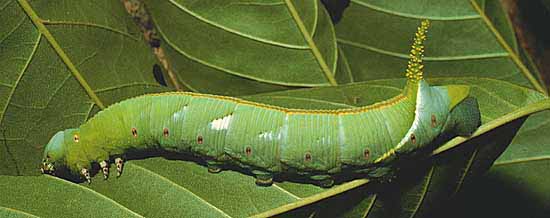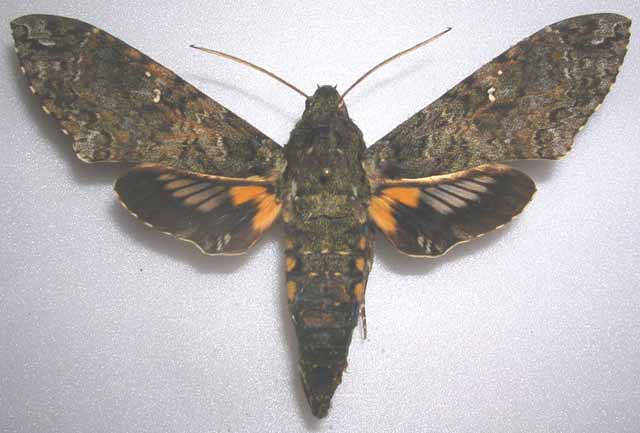Duponchel's Sphinx, Cocytius dupnchel
(Wing span: 4 5/16 - 5 7/8 inches (11 - 15 cm), males much smaller
than females)], flies in southern Brazil: Minas Gerais; southern Maranhoa.
It was at one time equated with duponchel. Jean Haxaire has indicated to me, August 17, 2019, that rivulus is a synonym of duponchel.
FLIGHT TIMES: Cocytius rivularis (now duponchel) adults nectar at flowers and brood continuously.
In Bolivia there are records for March-April and June-July-August-September-October-November-December.
Both males and females come to lights.
ECLOSION:Pupae probably wiggle to surface from subterranean chambers just prior to eclosion.
SCENTING AND MATING:Females call in the males with a pheromone released from a gland at the tip of the abdomen.
EGGS, LARVAE, PUPAE: Colourful larvae (not hairy, white posterior slash that fades into bluish,
1-2 white posterior costal slashes, maroon line down center of apple green back, 13.2 g as large last instar) feed on Guatteria diospyroides,
Annona purpurea, Annona reticulata, Xylopia frutescens and Custard apple (Annona glabra) and probably other members of the
Annonaceae family.
Moths emerge from pupae in as few as 21 days from pupation.
Use your browser "Back" button to return to the previous page.
Return to U. S.A. Table
Return to Sphingidae Index
Return to Sphingini Tribe
Use your browser "Back" button to return to the previous page.
Use your browser "Back" button to return to the previous page.
This page is brought to you by Bill Oehlke and the
WLSS. Pages are on space rented from Bizland. If you would like to become a "Patron of the Sphingidae Site", contact Bill.
Please send sightings/images to Bill. I will do my best to respond to requests for identification help.
Enjoy one of nature's wonderments: Live
Saturniidae (Giant Silkmoth) cocoons.
 | 
Show appreciation for this site by clicking on flashing butterfly to the left.
The link will take you to a page with links to many insect sites. |
|



